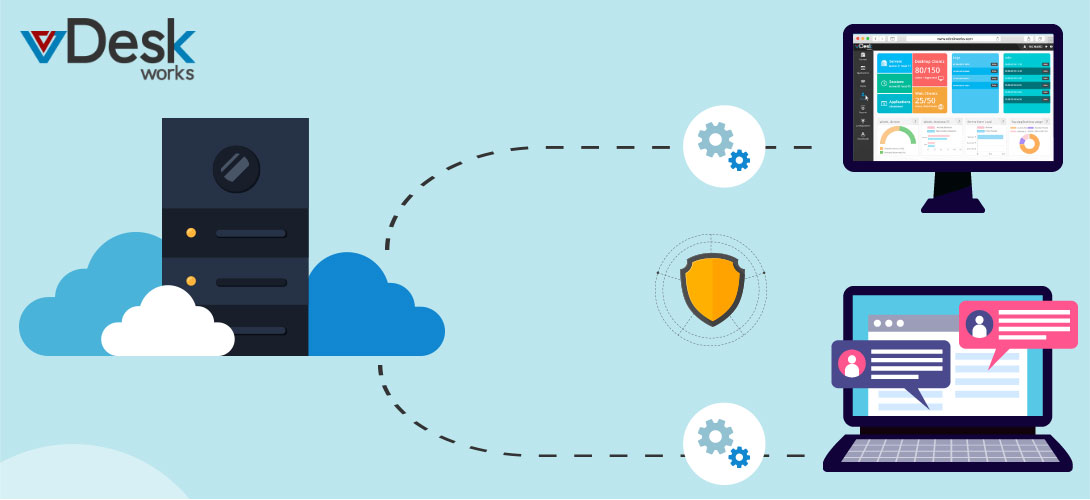Virtual desktops are more than just getting the work done. This technology can be used as a powerful tool that companies can benefit. Even though virtual desktops can be beneficial for many employees, companies’ key decision-makers will be able to add more value via the decisions they make. Companies’ key personnel might want to take a closer look at desktop virtualization and how it can benefit them. For greater benefits, they might want to consider using DaaS, which is a fully managed desktop as a service that provides additional advantages over in-house VDI.
Moving existing desktops to the cloud is one of the tasks which requires additional time when pursuing transformational changes that may require further groundwork for larger cultural and technological needs. With desktop as a service offering central location management, consistency, and ease of provisioning, it allows Chief Information Officers (CIOs) and their IT teams to focus on other larger business-driving initiatives. With the benefits of moving to virtual desktops, it gives CIOs something they may have interest in that may be lacking with traditional desktops. Most organizational employees use software that generates a great amount of data. With virtual desktop solutions that can offer insights and analytical capabilities, CIOs can have a better functional understanding of their employees, desktops, and how applications are performing. With this knowledge, CIOs can optimize tech stacks and computing resources to make better data-backed business decisions and recommendations.
The Authority of the Chief Information Officer In many organizations, the CIO is the individual who generally decides on the final decision for implementing virtual desktops. If the digital transformation expansion is on the agenda, then virtual desktops should be high on the list too.
Key Benefits- Provide IT professionals more time to focus on business-driven initiatives
- Reduce IT complexity by engaging in a fully functional Desktop as a Service provider
- Support departments and complexities with right-sized environments
- Enhance corporate data security and compliance
- Securely and efficiently support Bring Your Device and remote working programs
- Provide critical business data and insights to make smarter decisions
IT TeamsFor many organizations, there isn’t much capacity to expand the budgets or IT resources, but their responsibilities continue to gradually increase. To achieve the most out of the resources they have, tactical IT teams are leaning towards alternative solutions to help them achieve some routine tasks, such as provisioning a new desktop or troubleshooting, more efficiently and quicker.
Virtual desktops, which can be implemented for different sized company, makes it easy to provision, maintain, and troubleshoot desktops with half the effort put forth by traditional desktop management. Another advantage of using DaaS is that responsibilities can be simplified further. As solution experts, we will assist companies’ internal teams to properly design and tune their environments to the organization's unique specifications.
When it's time to provision new desktop versions or to deploy critical security updates, using DaaS will only consume a few minutes instead of many hours that are required with the traditional desktops.
Benefits for IT TeamsWhile many IT teams don't have the decision-making authority when it comes to making a significant change such as migrating to virtual desktops, they’re one of the many groups that can greatly benefit from it.
Key Benefits
- Centralized management allows for quick and easy provisioning, patching, and updates
- Easily create the right size environment, and deliver apps based on use cases and departments
- Allow for more time to focus on business-driven initiatives and other requirements
- Troubleshoot quickly with the real-time environment and user insights
- With Desktop as a Service, no need to support, maintain and replace infrastructure
- Legacy apps support for businesses
- Avoid OS updates compatibility issues
Security Pros:While significant data breaches are occurring more frequently and are widely reported, cybersecurity becomes more difficult to manage. And with more employees using their own personal devices, and with the increase in mobile and remote working, data management can be a nightmare for security pros.
Two ways virtual desktops can enhance security:
- Data are kept off the endpoint devices, meaning if a device is lost or stolen, data isn't compromised.
- It's easier to provision and consistently deploy security updates and controls. Protecting data at the desktop level might not seem like the ideal method for security professionals, but they ensure the data is protected at this base level, which goes a long way to safeguard overall corporate security. The risk of a cyberattack is much greater than the chance of someone stealing data, in a traditional sense. Cyberattack is not as simple as stealing hard copies. Therefore, security professionals need to work closely with the Chief Information Officer and other IT teams to design a comprehensive approach to data security, which includes both technologies and policies.
Strength of Security Pros:For some organizations, revenue is more relevant than data security. This thought provokes the Chief Information Security Officer and other security professionals to strongly advocate for change when it comes to implementing and designing virtual desktops.
Key Benefits:
- Easily and consistently administer security controls and measures to all employees
- Ensure the same level of security regardless of users’ locations, even for remote employees
- Security patches and updates can be quickly distributed to all users in the environment
- There’s no need to worry about data exposure when they’re lost or stolen


 Emma Carson
Emma Carson
















